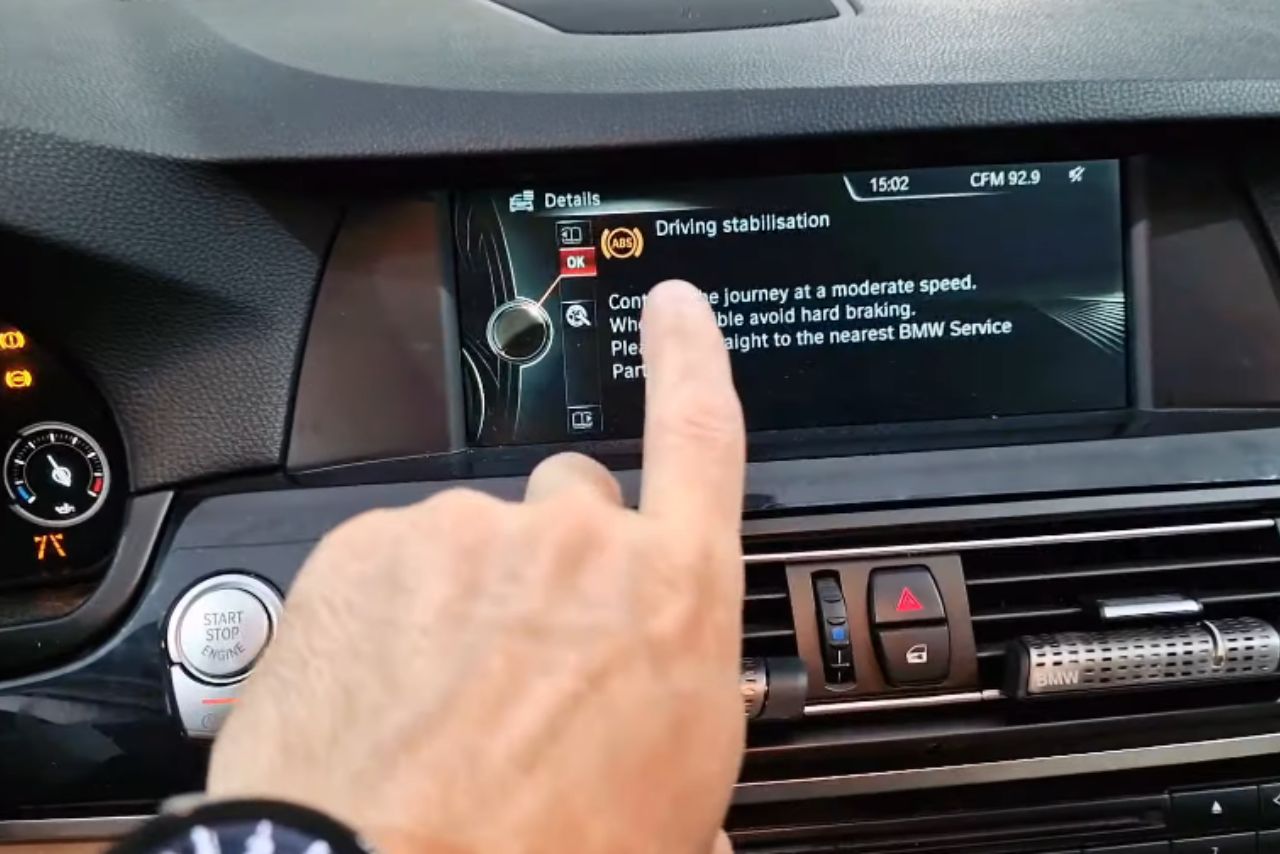Have you ever been cruising in your BMW and suddenly a “Driving Stabilisation” warning flashes on your dashboard? You’re not alone. This common issue boils down to an imbalance or malfunction within the car’s stabilizing system.
Essentially it means that there may be something off with your vehicle’s driving dynamics control systems which can include the engine management, brakes, or suspension components.
Experiencing the “Driving Stabilisation Bmw Error” warning in your BMW? This issue, often related to tyre pressure, ABS faults, or dynamic handling problems, requires professional diagnosis.
Driving Stabilisation BMW 100% Solution:
To resolve the “driving stabilisation” warning in your BMW 335i F30, consider checking the vehicle’s age and battery condition. Additionally, inspect the ABS sensor for potential faults. Utilize diagnostic tools such as iCarsoft or BimmerLink to read error codes and pinpoint the issue accurately.
Here In the below image You Can see the proof 👇, one of our reader who fixed his Driving Stabilisation BMW problem by using our method this issue was due to ABS Sensor and he replaced his ABS Sensor and the issue got fixed! 😍

Here is our another reader in this case this issue was due to front wheel sensor he replaced it and the issue got fixed 😍:

Issue:
The “Driving Stabilisation Drive Moderately” warning, accompanied by the traction control light, prevents changing driving modes. The problem persists even after turning off the ignition and reappears after driving a few miles.
Possible Causes:
Table of Contents
Meaning of Driving Stabilisation in BMW
The driving stabilization feature in a BMW vehicle is all about enhancing the safety and control while driving. It’s also known as Dynamic Stability Control (DSC), which is an advanced technology designed to improve stability.
This table presents a brief overview:
| Feature | Functionality |
|---|---|
| Wheel Speed Sensors | Monitor the rotational speed of each wheel |
| Steering Angle Sensor | Determines the desired direction from driver’s input |
| Lateral Acceleration Sensor | Measures side-to-side movement of car |
Key factors:
- A warning light on your dashboard indicates when there’s an issue with this system.
- Regular maintenance checks can help you keep tabs on its function.
- If needed, professional servicing can fix any issues promptly.
Remember, driving stabilization isn’t just about safety—it’s about making every drive smoother and more enjoyable!
Common Causes of Driving Stabilisation Issues:

Driving stabilisation issues in BMW cars can stem from various factors. Here are the common causes:
Below is a table summarizing these causes and their potential fixes:
| Cause | Potential Fix |
|---|---|
| Faulty Steering Angle Sensor | Replace the faulty sensor |
| Worn Out Tires | Regularly inspect and replace tires when necessary |
| Damaged Suspension Components | Repair or replace damaged components |
Remember, regular maintenance checks help identify these issues early on before they escalate into serious problems.
Symptoms of Driving Stabilisation Problems:

BMW driving stabilization problems can manifest in various ways. Here are the common symptoms to look out for:
Here’s a summarized table:
| Symptom | Description |
|---|---|
| Unexpected Steering Behavior | Car pulls to one side or resists steering |
| Warning Lights | ‘Driving Stability Control’ light illuminates |
| Braking Issues | Longer stopping distances / Uneven brake wear |
| Odd Noises | Squealing, Grinding, Clunking sounds from car |
| Tire Wear | Excessive tire wear especially on one edge |
Remember these symptoms don’t necessarily mean there’s a problem with driving stabilisation; they could be signs of other issues too! It’s always best to get any unusual behavior checked by professional mechanics promptly.
Diagnostic Methods for Driving Stabilisation in BMW:
If your BMW is experiencing driving stabilisation issues, here are the diagnostic steps to identify and fix the problem.
- Scan with OBD2 Scanner: An on-board diagnostics (OBD) scanner will provide error codes that can point to specific issues.
- Check Steering Angle Sensor: Ensure this sensor is functioning properly as it plays a crucial role in maintaining vehicle stability.
- Replace Faulty Abs Sensor:
- Replace Faulty Front Wheel Speed Sensor:
- Inspect ABS/DSC Module: Faulty ABS or DSC modules may lead to drive stabilisation problems.
Here’s a simple table showing common error codes related to driving stabilisation:
| Error Code | Possible Issue |
|---|---|
| 5DF0/5DF1 | Faulty ABS pump motor |
| 48069C | Steering angle sensor signal failure |
Once you’ve identified potential causes, proceed to these fixes:
- Replace faulty parts: Replace any defective components such as sensors or modules based on your diagnosis results.
- Software update: Sometimes an upgrade of the car’s software could rectify some minor issues.
- Professional help: If DIY methods don’t work, consider taking your BMW to a licensed service center for professional assistance.
Remember: Regular maintenance and immediate action upon noticing any unusual behaviors in your car contribute greatly towards preventing serious situations from developing further.
Watch this video to understand the problem:
Understanding the Electronic Stability Control System:
The Electronic Stability Control (ESC) system is a vital part of BMW’s driving stabilization technology. It aids in maintaining vehicle stability, especially during extreme steering maneuvers.
Here are some key points about the ESC:
| Component | Function |
|---|---|
| Wheel Speed Sensors | Monitor rotational speed of tires |
| Accelerometer | Measure lateral force |
| Yaw Rate Sensor | Monitor angular change while turning |
| Control Unit | Process sensor data & control braking |
If you’re facing issues with your BMW’s driving stabilisation feature due to malfunctioning ESC components, consult with a certified mechanic immediately for inspection and necessary repairs.
Remember: Regular maintenance checks can help ensure optimum functionality.
Troubleshooting Steps for Driving Stabilisation Issues:
If your BMW is having driving stabilization issues, don’t panic. Here’s a list of steps to troubleshoot and potentially fix the problem:
Faulty Front Wheel Speed Sensor:

To address the “Driving Stabilisation Drive Moderately” warning, consider replacing a potentially faulty front wheel speed sensor. This component, responsible for ABS and traction control, can trigger the warning if malfunctioning.
Check Tire Pressure:
Uneven or low tire pressure can cause stability problems.
- Use a tire pressure gauge
- Ensure each tire is properly inflated according to manufacturer’s specifications
Inspect Suspension System:
Look for signs of wear or damage.
- Examine shocks, struts, bushings
- Check if there are any fluid leaks
Examine Wheel Balance:
Unbalanced wheels can lead to instability.
- Have wheels professionally balanced
- Replace worn tires as needed
Investigate Steering System:
Loose steering components may affect vehicle stability.
- Inspect tie rods, ball joints
- Consider professional alignment check
Evaluate Brake System:
Worn out brake parts could be the culprit.
- Evaluate disc rotors for warping/signs of wear
- Replace old brake pads if necessary
Test Drive Control Module (DCM):
Faulty DCM might trigger false warnings.
- Use an OBD-II scanner to diagnose error codes related with DCM
- Reset or replace DCM as required
Remember: Always consult with a professional mechanic if you’re unsure about these procedures.
| Step | Task | Tools Needed |
|---|---|---|
| 1 | Check Tire Pressure | Tire pressure gauge |
| 2 | Inspect Suspension | Visual inspection/Professional help |
| 3 | Examine Wheel Balance | Professional wheel balancing service |
| 4 | Investigate Steering | Mechanic’s inspection/tools |
| 5 | Evaluate Brake System | Brake pad measuring tool |
| 6 | Test Drive Control Module | OBD-II scanner |
Software Updates and Recalibrations for BMW’s Driving Stabilisation System:
Driving stabilisation in a BMW vehicle is largely controlled by software. Let’s dive deep into how software updates and recalibration can help enhance this system.
Software Updates
- Periodic software updates are essential to ensure your BMW’s driving stabilization system operates at peak efficiency.
- These updates often contain fixes that address bugs, improve performance, or add new features.
- It’s recommended to check with your local dealership regularly for any available updates.
Recalibration Process
- Disconnect the battery and leave it disconnected for about 20 minutes.
- Reconnect the battery – This will reset all systems including the driving stabilization system.
- Start your vehicle and allow it to idle without touching anything such as gas or brake pedals.
- After about 10 seconds, turn off ignition completely then start again.
This process should recalibrate most of the sensors related to drive stabilization on your BMW car.
| Steps | Procedure |
|---|---|
| Step 1 | Disconnect Battery |
| Step 2 | Wait for around 20 Minutes |
| Step 3 | Reconnect Battery |
| Step 4 | Restart Vehicle and Idle |
| Step5 | Turn Off Ignition then Restart |
Remember, if you’re still experiencing issues after these steps, consult with a professional mechanic or take your car in for service at an authorized dealer!
Preventive Measures to Maintain Optimal Driving Stabilisation in Your BMW:
Regular maintenance and proper care of your BMW can go a long way towards ensuring optimal driving stabilization. Here are some key measures you should take:
Remember, preventative care not only ensures optimal driving stabilisation but also extends the lifespan of your valuable asset!
Conclusion and final thoughts
In the realm of luxury vehicles, BMW stands out for its advanced driving stabilization features. These systems significantly enhance safety and control, offering drivers confidence on varied road conditions.
Although issues may occasionally arise – like a malfunctioning DSC or an error message displayed on your dashboard – it’s crucial not to panic.
Understanding what these notifications mean will help you make informed decisions about your vehicle’s maintenance needs. There are many causes behind such problems, including worn-out components or system glitches.
The good news? Most of these can often be fixed with professional assistance or by following manufacturer guidelines diligently.
That way, you’ll ensure that your BMW continues to deliver optimum performance and keeps you safe on all your journeys.




Leave a Reply